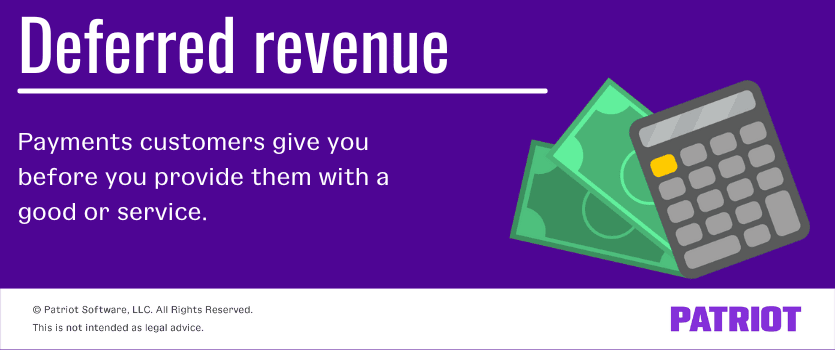Do customers pay you for your goods or services before you actually deliver them? If so, you need to know about deferred revenue. Learn about deferred revenue and how to record it in your accounting books.
What is deferred revenue?
Deferred revenue refers to payments customers give you before you provide them with a good or service. The payment is not yet revenue because you haven’t earned it. Deferred revenue is common in businesses where customers pay a retainer to guarantee services or prepay for a subscription. Deferred revenue is sometimes called unearned revenue, deferred income, or unearned income.

As you deliver goods or perform services, parts of the deferred revenue become earned revenue. For example, if you charge a customer $1,200 for 12 months of services, $100 per month will turn into earned revenue while the remaining amount will still be deferred revenue. So, after 3 months, you will have $300 in earned revenue and $900 in deferred revenue.
Deferred revenue example
To help you understand deferred revenue, here’s a deferred income example.
Let’s say you run a cleaning business. Customers can purchase a six-month subscription to get a discounted rate. They pay you the full amount at the beginning of the six-month period, and you perform the services over the six months.
The amount customers pay you in advance for your cleaning subscription is the deferred revenue. As you perform your cleaning services, parts of the deferred revenue become earned revenue. So, if you clean for a client once per week, the amount of money equal to the weekly service becomes earned revenue after you perform the service each week.
How to record deferred revenue
You will record deferred revenue on your balance sheet. What type of account is deferred revenue? You will record deferred revenue on your business balance sheet as a liability, not an asset.
Receiving a payment is normally considered an asset. But, prepayments are liabilities because it is not yet earned, and you still owe something to a customer. The deferred revenue turns into earned revenue (which is an asset) only after the customer receives the good or service.
Let’s say you own a candy shop. A customer pays you $180 for a 12-month candy subscription. You need to make a deferred revenue journal entry. When you receive the money, you will debit it to your cash account because the amount of cash your business has increased. And, you will credit your deferred revenue account because the amount of deferred revenue is increasing.
| Date | Account | Notes | Debit | Credit |
| 1/11 | Cash | Payment for candy subscription | 180.00 | |
| Deferred revenue | 180.00 |
Each month, one-twelfth of the deferred revenue will become earned revenue. In this case, $15 per month will become revenue. You must make an adjusting entry to decrease (debit) your deferred revenue account and increase (credit) your revenue account.
| Date | Account | Notes | Debit | Credit |
| 1/11 | Deferred Revenue | One month of candy subscription | 15.00 | |
| Revenue | 15.00 |
How to calculate deferred revenue
Deferred revenue is easy to calculate. When a customer gives you an advance payment, you will increase your deferred revenue account. As you deliver goods or services, your deferred revenue account will decrease.
Make accounting easy with online accounting software. With Patriot’s small business accounting software, you can quickly add entries and view reports. Get your free trial now.
This article is updated from its original publication date of January 11, 2018.
This is not intended as legal advice; for more information, please click here.


